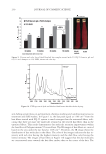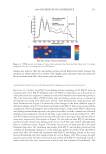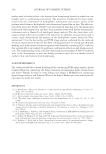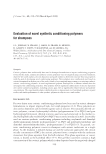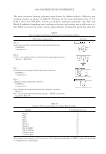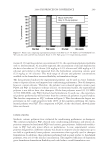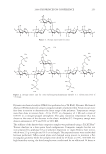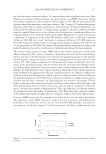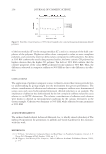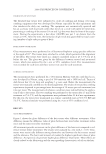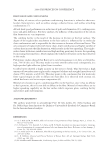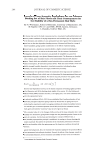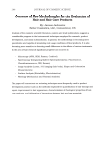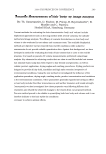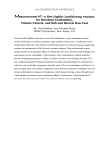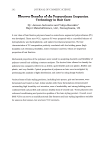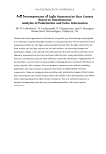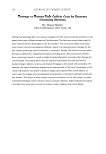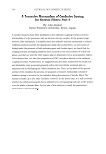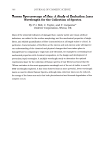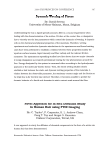J. Cosmet. Sci., 60, 251–259 (March/April 2009) 251 The mechanics of fi xatives as explained by polymer composite principles DENISE WADE RAFFERTY, JOSEPH ZELLIA, DANIEL HASMAN, and JOHN MULLAY, Lubrizol Advanced Materials, Inc., Noveon® Consumer Specialties, 9911 Brecksville Rd., Brecksville, OH 44141-3201. Synopsis Polymer composite principles are shown to explain the mechanism and performance of fi xative-treated hair tresses. This concept is illustrated using cassia and experimental cassia hydroxypropyltrimonium chloride derivatives at two charge densities. Correlations are drawn between polymer fi lm and fi xative performance properties, and the primary mechanisms behind the performance of each polymer are suggested. The cationic charge density affects the adhesion and cohesion of these polymers, and the contributions of these two proper- ties to performance are shown. It is also shown that the relationship between cationic charge density and fi xative stiffness of these polymers is dependent on the relative humidity (RH) of the test. The lower charge density polymer yields higher tress stiffness than the higher charge density polymer at 50% RH, but this trend is reversed at 90% RH. A hy- pothesis is offered in explanation of this phenomenon, relating adhesion and cohesion to the performance of fi xative-hair composites. At high humidity, moisture can plasticize the polymers, reducing the cohesive strength, so electrostatic attraction and thus adhesion becomes the dominant force. Evidence to support this hypothesis is given. INTRODUCTION Hair fi xative gels are widely used to create and maintain a variety of hairstyles. Two im- portant properties desired in hair gel products are stiffness and hold, which are controlled by the fi xative polymer in the formulation. To satisfy increasing consumer demands, per- formance with respect to these properties must be improved relative to the current fi xa- tive polymers. Understanding the science behind fi xative gel-treated hair is essential to achieving these improvements. A hair fi xative gel is a cosmetic product however, its performance is governed by polymer composite mechanisms. When a gel is applied to the hair, a polymer-fi ber composite is created that is morphologically similar to high performance fi ber composites (1) used in load-bearing applications. The differences between fi xative-treated hair and industrial fi ber composites are primarily in the mode of fabrication and the performance specifi cations. Correspondence should be addressed to Denise Wade Rafferty.
JOURNAL OF COSMETIC SCIENCE 252 Industrial composites start with the polymer and add fi bers for reinforcement there is a critical amount of fi bers that must be achieved for strengthening. In contrast, fi xative composites start with fi bers (hair), and a minimum amount of polymer gel must be used to achieve composite strength properties. As is the case for the industrial composites, the hair fi bers provide the primary strength to the fi xative composite. (With respect to fi xa- tive gel products, this sometimes goes against popular belief.) In both cases, it is impor- tant that the polymer adheres to the fi bers (2). The fi xative gel glues multiple hair fi bers together, creating a composite fi ber with a larger effective diameter, and thus, higher stiffness. Good adhesion between the polymer and the fi bers allows stress transfer be- tween the polymer and fi ber and is necessary to achieve composite properties. Polymer cohesion, which is affected by molecular weight, architecture, crystallinity, polar interac- tions, hydrogen bonding, environmental conditions and additives, contributes to the composite strength when there is suffi cient polymer-hair adhesion (3). To demonstrate the connection of composite science and cosmetic formulation, the effect of cationic substitution on the polymer fi lm and the composite mechanical properties will be shown for cassia and two experimental hydroxypropyltrimonium chloride derivatives (Lubrizol Advanced Materials, Inc., Noveon® Consumer Specialties). Film testing will show how the cationic charge density affects the cohesive properties of the polymer, and testing fi xative-hair composites will provide a measure of the combined adhesive and cohesive properties. The results will be considered with respect to polymer composite principles, and the implications for the balance of adhesion and cohesion in fi xative mech- anisms will be discussed. EXPERIMENTAL MATERIALS Cassia gum (cassia tora and cassia obtusifolia) and experimental cassia hydroxypropyltri- monium chloride (cassia HPTC) polymers, with cationic substitution levels of 1.8 and 3.0 meq/g, were used for this work. The average repeat units of cassia and cassia HPTC with a charge density of 3.0 meq/g are shown in Figures 1 and 2, respectively. Preparation of these derivatives has been described elsewhere (4). Polymer dispersions were prepared using 0.5, 1.0 and 2.0 weight percent (solids) cassia polymer. The cassia HPTC polymers were cold- water dispersed, and cassia gum was heated to 80°C for 30 minutes to disperse. SAMPLE PREPARATION AND METHODS Polymer fi lms were prepared by pouring the dispersions into Tefl on-coated foil troughs and allowed to evaporate for a minimum of seven days at 23°C, 50% relative humidity (RH). The resultant dry fi lm was approximately 0.20 mm thick. Tensile testing of the fi lms was done with a TA.XT.Plus® Texture Analyser (Texture Technologies). All testing was performed at 23°C, 50% RH using the sample geometry described in ASTM D 882-02 (5) and a rate of 5 cm/min. Tensile strength, calculated as the maximum of the stress versus strain curve, and elongation at break were obtained for comparison.
Purchased for the exclusive use of nofirst nolast (unknown) From: SCC Media Library & Resource Center (library.scconline.org)









































































































































